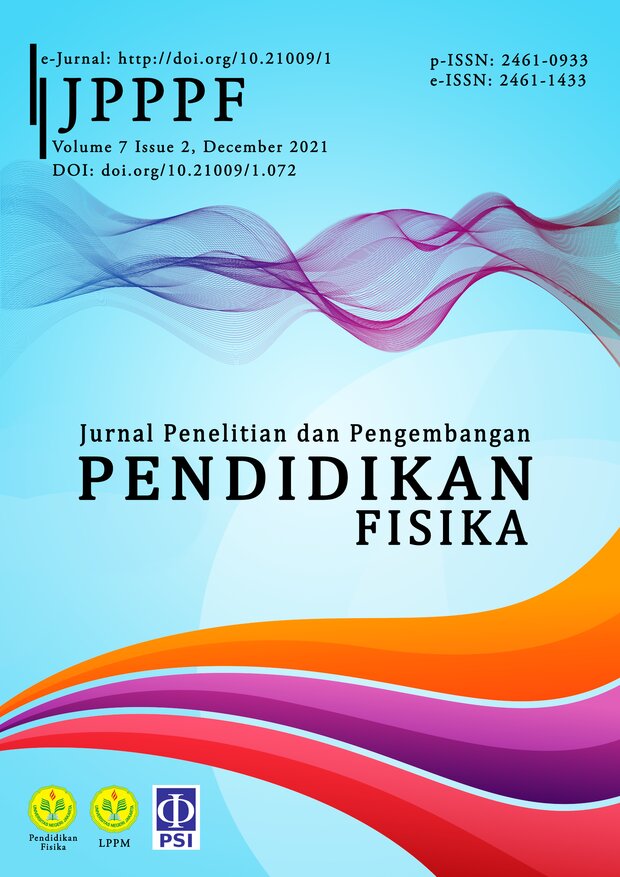The E-Learning Design for Problem Based Learning in Dynamic Fluid Topic using Microsoft Sway
DOI:
https://doi.org/10.21009/1.07203Keywords:
e-learning, microsoft sway, dynamic fluid, problem based learningAbstract
The development of information and communication technology (ICT) based on education can be an opportunity to improve the learning process. Learning in the pandemic era Covid-19 needs media that help teachers and students enthusiasm for learning. The lessons with e-learning are flexible and easy to use. Microsoft Sway 365 is one of the e-learning that can be used because of the features such as presentation, text, images, video, and sound. This study aims to produce e-learning using Microsoft Sway on Dynamic Fluid. This study uses an R&D method with the 4D model but only defines, designs, and develops stages. Media experts and material experts validated the e-learning. The validity test result from content experts showed that the e-learning using sway was feasible with 77.7% and from media experts was feasible with 77.5%. The study concludes that e-learning with Microsoft Sway is flexible, easy to use, can support physics learning with fun, and feasible to be used as a teaching medium that helps students in explanatory activities.
References
Alshammari, SH 2018, ‘LMS, CMS and LCMS: The Confusion Among Them’, Sci.Int.(Lahore), vol. 30, no. 3, pp. 455-456.
Ardian, S, Hasanah, WK, & Rana, FI 2020, ‘Pemanfaatan Microsoft Sway Dan Microsoft Form Sebagai Media Interaktif Dalam Pembelajaran Sejarah’, Bihari: Pendidikan Sejarah dan Ilmu Sejarah, vol. 3, no. 2, pp. 68-73.
Astuti, LW 2019, ‘Pengembangan Media Pembelajaran Berbasis Sway Pada Mata Pelajaran TIK’, Jurnal TEKNODIK, vol. 23, no. 2, pp. 164-165.
Bakri, F, Sunaryo, S, Irawan, VF & Muliyati, D 2018, ‘E-Learning Model for Problem Based Learning on Heat and Thermodynamic Topics in High School’, Jurnal Penelitian & Pengembangan Pendidikan Fisika, vol. 4, no. 2, pp. 101 - 112.
Cha, H, Taejung P & Seo, J 2020, ‘What Should Be Considered when Developing ICT-Integrated Classroom Models for a Developing Country?’, MDPI Multidisciplinary Digital Publishing Institute, vol. 12, no. 7.
Chang, V 2016, ‘Review and discussion: E-learning for academia and industry’, International Journal of Information Management, vol. 36, p. 477.
Costaner, L 2020, ‘E-Learning Feasibility Analysis: Dwi Sejahtera Vocational High School Pekanbaru Context’, IOP Conference Series: Earth and Environmental Science, vol. 469, no. 012038.
Daniel, SJ 2020, ‘Education and the COVID-19 pandemic’, Prospects, vol. 49, pp. 91-96.
Diani, R, Yuberti, Y, & Syarlisjiswan, MR 2018, ‘Web-Enhanced Course Based On Problem-Based Learning (Pbl): Development Of Interactive Learning Media For Basic Physics II’, Jurnal Ilmiah Pendidikan Fisika Al-BiRuNi, vol. 7, no. 1
Glazunova, OG & Kusminska, OG 2017, ‘Е-Environment Based On Microsoft Sharepoint For The Organization Of Group Project Work Of Students At Higher Education Institutions’, Information Technologies and Learning Tools, vol. 62, pp. 98-101.
Guntara, Y & Utami, IS 2021, ‘Implementation of Augmented Physics Animation Integrated Crosscutting Concept COVID 19 in Facilitating Problem Solving Skills and Disaster Preparedness’, Jurnal Penelitian & Pengembangan Pendidikan Fisika, vol. 7, no. 1, pp. 43 - 52.
Halim, A 2018, ‘Development Of Two-Tier Diagnostic Test Based On E-Learning’, The 8th International Conference on Theoretical and Applied Physics, vol. 1120, p. 012030.
Kamarudiin, E & Wijaya, YS 2021, ‘Development of prototype e-learning mathematics learning tools using Moodle’, IOP Conference Series: Materials Science and Engineering, vol. 1098, no. 022095.
Kiryakova, G 2017, ‘Application Of Cloud Services in Education’, Trakia Journal of Sciences, vol. 15, no. 4.
Krouska, A, Troussas, C & Virvou, M 2017, ‘Comparing LMS and CMS Platforms Supporting Social e-Learning in Higher Education’, Software Engineering Laboratory, Department of Informatics, pp. 1-2.
Mahendra, MR 2021, ‘Development of Macromedia Flash-Based Mathematics Learning for Elementary School Student’, Annual Conference on Science and Technology Research (ACOSTER) 2020, vol. 1783, p. 12006.
Malik, A 2015, ‘Model Pembelajaran Problem Based Instruction untuk Meningkatkan Penguasaan Konsep dan Keterampilan Proses Sains Mahasiswa’, Jurnal Penelitian & Pengembangan Pendidikan Fisika, vol. 1, no. 1, pp. 9-16.
Martyaningrum, ID 2021, ‘The impact of problem based learning model through e-learning on students’ critical thinking ability’, Journal of Physics: Conference Series, vol. 1806, no. 012085.
Muliyati, D, Marizka, H & Bakri, F 2019, ‘E-Learning Using Wordpress on Physics Materials with The 5E Learning Cycle Strategy’, Jurnal Penelitian & Pengembangan Pendidikan Fisika, vol. 5, no. 2, pp. 101-112.
Rahmadani, NS & Setiawati, M 2019, ‘Aplikasi Pendidikan Online “Ruang Guru”Sebagai Peningkatan Minat Belajargenerasi Milenial Dalam Menyikapi Perkembangan Revolusi Industri 4.0’, Jurnal Pendidikan dan Sastra Indonesia, vol. 2, no. 3, p. 243.
Regmi, K 2020, ‘A systematic review of the factors enablers and barriers- affecting e-learning in health sciences education’, Regmi and Jones BMC Medical Education, vol. 20, no. 91.
Roza, L, Aulia, N & Zulherman, Z 2021, ‘Analisa Pemanfaatan E-Learning Menggunakan Data Statistik Pengguna Aplikasi Startup Pendidikan Selama Wabah Pandemi Covid-19’, Jurnal Pendidikan Sains Indonesia, vol. 9, no. 3, pp. 407-419.
Savidis, A 2016, ‘Developing inclusive e-learning and e-entertainment to effectively accommodate learning difficulties’, Foundation for Research and Technology-Hellas (FORTH), vol. 5, p. 402.
Setyowati, R, Sarwanto, S & Muzzazinah, M 2020, ‘How Students’s Higher Order Thinking SkillsThrough E-Learning During the Covid-19 Pandemic? What does it have to do with’, Journal of Physics: Conference Series, vol. 1808, no. 012032.
Silver, H & Cindy, E 2004, ‘Problem-Based Learning: What and How Do Student Learn’, Educational Psychology Review, vol. 16, no 3, pp. 235-237.
Sugiyono 2013, ‘Metode Penelitian Pendidikan Pendekatan Kuantitatif, kualitatif, dan R&D’, Bandung: Alfabeta.
Usman, RK 2020, ‘The Use of Microsoft Sway 365 in Teaching Reading Descriptive Text: A Response to Pandemic Situation’, Journal of English Language Teaching and Cultural Studi, vol. 3, no. 2, pp. 82-85.
Yaniawati, RP 2019, ‘E-learning assisted problem based learning for self-regulated learning and mathematical problem solving’, Journal of Physics: Conference Series, vol. 1280, no. 042023.
Zuo, M, Ma, Y, Hu, Y & Luo H 2021, ‘K-12 Students’ Online Learning Experiences during COVID-19: Lessons from China’, Front Educ China, vol. 16, pp. 1-30.











